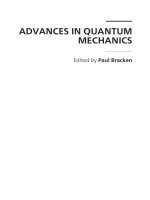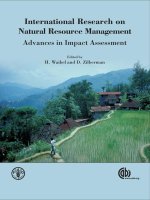Advances in international investments
Bạn đang xem bản rút gọn của tài liệu. Xem và tải ngay bản đầy đủ của tài liệu tại đây (2.7 MB, 309 trang )
ADVANCE$ IN
INTERNATIONAL INVE$TMENT$
Traditional and Alternative Approaches
b594_FM.qxd
3/27/2008
2:26 PM
Page ii
This page intentionally left blank
ADVANCE$ IN
INTERNATIONAL INVE$TMENT$
Traditional and Alternative Approaches
editors
Hung-Gay Fung
University of Missouri, St Louis, USA
Xiaoqing Eleanor Xu
Seton Hall University, USA
Jot Yau
Seattle University, USA
World Scientific
NEW JERSEY
•
LONDON
•
SINGAPORE
•
BEIJING
•
SHANGHAI
•
HONG KONG
•
TA I P E I
•
CHENNAI
Published by
World Scientific Publishing Co. Pte. Ltd.
5 Toh Tuck Link, Singapore 596224
USA office: 27 Warren Street, Suite 401-402, Hackensack, NJ 07601
UK office: 57 Shelton Street, Covent Garden, London WC2H 9HE
Library of Congress Cataloging-in-Publication Data
Advances in international investments : traditional and alternative approaches /
edited by Hung-Gay Fung, Xiaoqing Eleanor Xu & Jot Yau.
p. cm.
ISBN-13: 978-981-270-862-5
ISBN-10: 981-270-862-6
1. Investments, Foreign. 2. Capital movements. 3. International economic
relations. I. Fung, Hung-gay. II. Xu, Xiaoqing Eleanor. III. Yau, Jot.
HG4538.A48 2008
332.67'3--dc22
2007048502
British Library Cataloguing-in-Publication Data
A catalogue record for this book is available from the British Library.
Copyright © 2008 by World Scientific Publishing Co. Pte. Ltd.
All rights reserved. This book, or parts thereof, may not be reproduced in any form or by any means,
electronic or mechanical, including photocopying, recording or any information storage and retrieval
system now known or to be invented, without written permission from the Publisher.
For photocopying of material in this volume, please pay a copying fee through the Copyright
Clearance Center, Inc., 222 Rosewood Drive, Danvers, MA 01923, USA. In this case permission to
photocopy is not required from the publisher.
Typeset by Stallion Press
Email:
Printed in Singapore.
PohHoon - Advs in Intl Investments.pmd
1
7/23/2008, 6:56 PM
b594_FM.qxd
3/27/2008
2:26 PM
Page v
To my parents, Linda (wife), Anna (daughter), my brothers and sister.
H.-G. Fung
To my mom, Jiong (husband), Gloria and Joanna (daughters),
brother, and the loving memory of my dad.
X. E. Xu
To Marie, my parents, brothers, and sisters.
J. Yau
v
b594_FM.qxd
3/27/2008
2:26 PM
Page vi
This page intentionally left blank
b594_FM.qxd
3/27/2008
2:26 PM
Page vii
Preface
In recent years, the globalization of the financial markets has become
increasingly accelerated, leading to an integrated world market. At the
same time, emerging markets such as China and India have opened up
their markets to foreign investors, providing more investment opportunities for the existing investment universe. In addition, more new
global investment instruments such as exchange-traded funds are
created, enabling investors to fine-tune their investment portfolios.
Financial investments are expanded to include real asset investments
such as natural resources and real estate investments. Thus, there is a
need to better understand the full range of investments available in
the global market.
There are two basic approaches that are useful in understanding
international investments. The first is presenting and discussing risk/
return tradeoffs such as foreign exchange risk, regulatory risks, and
different market impediments in global financial markets. The second
is identifying different asset classes and current issues pertaining to
them in a changing global environment. We adopt the second approach
in this book because it contains more relevant information about the
current state of global investments. Current hot topics (new financial
instruments, innovations, and strategies), are identified and different
authors who have expertise in various aspects of international investments are solicited to write for each chapter. Each chapter focuses on
the risk and opportunities related to the current topic or the financial instrument, innovation, and/or strategy identified. In addition,
vii
b594_FM.qxd
viii
3/27/2008
2:26 PM
Page viii
Preface
alternative investment instruments are included, enabling readers to
have a richer and a more complete understanding of the global investment opportunities.
For easy reference and organization, chapters are organized by
asset class, which can be labeled as the traditional and alternative
investments. The thread that runs through the entire book is:
(1) trends (what is the current topic/instrument/strategy in the chosen asset class), (2) opportunities (what is new and/or where to invest
or arbitrage, i.e., location); and (3) risks (what are the risks, i.e., peculiar to the location and how international investors can manage/
reduce/eliminate the respective risks).
This book has 11 chapters. The first two chapters are the introduction and an overview of global investments. The next two chapters
are related to global equity investments, followed by one on global
fixed income investments and portfolio management. Four chapters
are on alternative investments. The final two chapters are on derivatives and their use in risk management.
b594_FM.qxd
3/27/2008
2:26 PM
Page ix
About the Editors
Hung-Gay Fung is Dr. Y. S. Tsiang Chair Professor of Chinese Studies
at College of Business Administration, University of Missouri–St.
Louis. Dr. Fung’s research covers international finance, international
banking, and Chinese financial markets. He has published over 100
scholarly papers in leading academic journals and in professional journals. He has also published five books. He is the recipient of many
grants and academic awards. As a senior expert of Chinese finance
studies, Dr. Fung has organized many international conferences and
symposiums. He received his PhD in Finance from Georgia State
University in 1984 and BBA in Finance from the Chinese University
of Hong Kong in 1978.
Xiaoqing Eleanor Xu is Professor of Finance at the Stillman School
of Business, Seton Hall University. Her research covers fixed income,
venture capital, hedge funds, emerging markets and security market
microstructure. She has published over 20 research articles in journals such as Journal of Banking and Finance, Real Estate Economics,
Financial Analysts Journal, Journal of Portfolio Management, Journal
of Futures Markets, and Financial Review. She is the recipient of many
research grants and academic awards, including the 2006 Seton Hall
Researcher of the Year Award and the 2007 New Jersey Bright Idea
in Finance Award. She received her PhD in Finance from Syracuse
University in 1998 and MBA from Indiana State University in 1994.
Dr. Xu is a CFA charterholder.
ix
b594_FM.qxd
x
3/27/2008
2:26 PM
Page x
About the Editors
Jot Yau is Robert D. O’Brien Endowed Chair in Business Administration and Professor of Finance at Seattle University. Since joining
Seattle University in 2001, he has served as the chair of the Department
of Finance and MSF program director. He has published numerous
articles in scholarly and practitioner-oriented finance journals and
chapters in professional books. He has been serving on the editorial
board of The Journal of Alternative Investments since 2001 and served
as its Associate Editor from 2001–2005. He has served on the exam
and curriculum committees of the CFA Institute and the CAIA
Association and has written curriculum materials for the CFA exam
program. He has co-founded Strategic Options Investment Advisors
Ltd., a Hong Kong-based investment advisory and served as its
principal investment advisor and commodity trading advisor from
1998–2005. He is currently the treasurer of the Northwest Hedge
Fund Society and a member of the board of directors of GHCU
(Group Health Credit Union). Dr. Yau has worked for George Mason
University, Independent Research & Consulting, Kidder Peabody,
TRS Associates, Shearson/American Express, and Dow Chemical.
Dr. Yau holds a PhD degree in Finance from the University of
Massachusetts at Amherst. He is a CFA charterholder.
b594_FM.qxd
3/27/2008
2:26 PM
Page xi
List of Contributors
Sheryl A. Law received a Master of Science in environmental chemistry from the University of Toronto and a Master of Business Administration from Seattle University. She has worked in environmental
research at universities, government institutions, and spent many years
working at a science and engineering consulting firm. She is the
founder of Peregreen Group, a financial research and analytics firm
specializing in socially responsible investing and corporate sustainability.
Louis T. W. Cheng, CFPCM, DBA, is an Associate Professor of Finance
at the School of Accounting and Finance. From 1989–1998, he was
an Associate Professor of Finance at Murray State University in
Kentucky. In 2003, he served as the HSBC Fellow of Asian Financial
Markets at the University of Exeter in the UK. He is an author of
Fundamentals of Financial Planning by McGraw-Hill, 2006.
Moreover, he has over 60 articles published in top finance research
journals including the Journal of Finance. He is ranked among the
top ten finance professors in the Asia-Pacific in terms of research by
articles in the Pacific Basin Finance Journal in 2001 and 2005.
Yiuman Tse is Professor of Finance and US Global Investors Inc.,
Fellow at The University of Texas at San Antonio (UTSA). His research
interests are international financial markets and investments. He has
papers recently published in Journal of Financial and Quantitative
Analysis and Review of Financial Studies. He received his PhD at
Louisiana State University in 1994 and taught at the State University
xi
b594_FM.qxd
xii
3/27/2008
2:26 PM
Page xii
List of Contributors
of New York at Binghamton and The University of Memphis. Professor
Tse is the recipient of many teaching awards from different universities,
including the President’s Distinguished Achievement Awards for
Teaching Excellence at UTSA.
Grace K. Yeung, CPA, CA, CFA is a Senior Manager at PricewaterhouseCoopers Hong Kong where she serves the investment management industry sector. Grace received her MA in Economics from the
University of California at Berkeley. She has been practising public
accounting for 10 years. Grace has extensive experience in audit services, compliance matters and internal controls. Her client base includes
hedge funds and private equity funds with various investment and
trading strategies. She is also closely involved with the fund managers
and the service providers to the investment management industry
such as fund administrators, trustees and custodians. Grace is a member of the Council of Examiners of the CFA Institute. Her responsibilities include reviewing the CFA Study and Examination Program
reading materials as well as writing and proof-reading exam questions.
She is also a grader of the CFA exam.
Gary A. Patterson received his PhD in Finance from the University
of North Carolina–Chapel Hill. His research interests include real
estate investments and studies of market efficiency. He has published
in Journal of Banking, Journal of Alternative Investments, Journal of
Futures Markets and Journal of International Financial Markets, and
Institutions and Money. He currently resides in St. Petersburg, Florida.
Aysegul Ates is an Assistant Professor of Economics at the Akdeniz
University. She received her PhD in Economics from American
University in Washington DC. Prior to her current position, she worked
as an economist at the Commodity Futures Trading Commission. Her
research focuses on derivative markets. Her research has been published in Journal of Futures Markets and Review of Futures Markets.
George H. K. Wang is Research Professor of Finance in the School
of Management at George Mason University. He received his PhD in
b594_FM.qxd
3/27/2008
2:26 PM
Page xiii
List of Contributors
xiii
Statistics and Economics (double majors) from Iowa State University,
Ames, Iowa. He was the Deputy Chief Economist and Director of
Research at the US Commodity Futures Trading Commission.
Dr. Wang was Visiting Professor of Finance, Faculty of Economics
and Business, University of Sydney, Sydney, Australia in the summer
of 2006 and 2007 and Visiting Professor at National Central
University, Taiwan in July 2007. He has published widely in major refereed journals in the areas of derivatives markets, applied time series,
econometrics, mortgage markets, and transportation. He is an elected
ordinary member of International Statistical Institute and a member
of the editorial board of the Journal of Futures Markets.
Gaiyan Zhang is Assistant Professor of Finance at College of Business
Administration at the University of Missouri–St. Louis. She holds a
PhD from the University of California at Irvine, a MS in Finance from
Fudan University and a BA in Finance from Nankai University, China.
Her research interests include credit risk and credit derivatives, empirical corporate finance, and international finance. Her work has
appeared in Journal of Financial Economics, Journal of Fixed Income,
and Chinese Economy.
Anthony L. Loviscek is an Associate Professor of Finance and Chair
of the Department of Finance and Legal Studies at Seton Hall
University. He has also held appointments at West Virginia University,
Indiana University-Purdue University at Fort Wayne, and Princeton
University. His research interests are in financial markets and portfolio analysis. His work has appeared in the Financial Review, The
Quarterly Review of Economics and Finance, Financial Services Review,
Journal of Real Estate Portfolio Management, North American Review
of Economics and Finance, and The Southern Economic Journal.
b594_FM.qxd
3/27/2008
2:26 PM
Page xiv
This page intentionally left blank
b594_FM.qxd
3/27/2008
2:26 PM
Page xv
Contents
Dedication
v
Preface
vii
About the Editors
ix
List of Contributors
xi
Part I: General Issues of International Investments
1
Chapter 1:
International Investment: Current State and
Challenges from the US Perspective
Hung-Gay Fung, Xiaoqing Eleanor Xu and
Jot Yau
3
Chapter 2:
Socially Responsible Investing: Growth
and Development in International
Financial Markets
Sheryl A. Law and Jot Yau
Part II: Traditional Investments
31
73
A. Global Equity Investments
Chapter 3:
Global Equity Investments and Analysis
Louis T. W. Cheng
75
Chapter 4:
Exchange-Traded Funds
Yiuman Tse
97
xv
b594_FM.qxd
xvi
3/27/2008
2:26 PM
Page xvi
Contents
B. Global Fixed Income Investments
109
Chapter 5:
111
Global Fixed Income Markets and Portfolio
Management
Xiaoqing Eleanor Xu
Part III: Alternative Investments
135
Chapter 6:
Hedge Funds
Jot Yau and Grace K. Yeung
137
Chapter 7:
International Real Estate
Gary A. Patterson
161
Chapter 8:
Global Perspectives on Venture Capital
and Private Equity
Xiaoqing Eleanor Xu
187
Chapter 9:
Managed Futures
Aysegul Ates and George H. K. Wang
211
Part IV: Derivatives
229
Chapter 10:
Credit Derivatives: Trends, Challenges
and Opportunities
Gaiyan Zhang
231
Chapter 11:
Currency Derivatives and Emerging Market
Currencies: Strategies, Perspectives,
and Trends
Anthony L. Loviscek
259
Index
289
b594_Chapter-01.qxd
3/27/2008
10:32 AM
Page 1
Part I: General Issues of International
Investments
b594_Chapter-01.qxd
3/27/2008
10:32 AM
Page 2
This page intentionally left blank
b594_Chapter-01.qxd
3/27/2008
10:32 AM
Page 3
Chapter 1
International Investment:
Current State and Challenges
from the US Perspective
Hung-Gay Fung*, Xiaoqing Eleanor Xu†
and Jot Yau‡
We discuss the growth of world financial markets with common stocks,
bonds, and other new financial instruments such as futures, GDRs and ETFs.
We document patterns of international capital flows and discuss their related
issues, which include: 1) how capital flows affect economic growth; 2) the
cost of capital; and 3) increased linkages among different markets around
the world. Home bias in global investment remains an issue that is not
easily explained in the light of globalization.
We also discuss patterns of foreign portfolio investments and their implications for US investors. We show the importance of various types of investments in terms of maturity and asset class. The most popular industries for
foreign investors are Thrifts and Mortgage Finance, Pharmaceutics, Metals
and Mining, Paper and Forest Products, and Media and Insurance.
Keywords: Global investment; home bias; capital flows; global market linkage;
cost of capital.
* College of Business Administration, University of Missouri–St. Louis, One University
Boulevavd, St. Louis, MO 63121, USA. Email:
†
Stillman School of Business, Seton Hall University, 400 South Orange Avenue, South Orange,
NJ 07079, USA. Email:
‡
Albers School of Business and Economics, Seattle University, 901 12th Avenue, Seattle, WA
98122-1090. Email:
3
b594_Chapter-01.qxd
4
3/27/2008
10:32 AM
Page 4
H.-G. Fung, X. E. Xu and J. Yau
1. Introduction
Financial markets across the globe are overflowing with common
stocks, bonds, and other financial instruments such as futures and
options. In terms of market capitalization, the three largest regions
are the US, the Euro area, and Japan, representing US$47.6 trillion,
US$26.6 trillion, and US$17.3 trillion of the financial assets, respectively (Table 1). As of 2004, equities were apparently the key driver
of the growth of global financial assets and the key component in the
financial markets, while bonds accounted for 36% of US$122.6 trillion of the world’s financial assets, and 40% of the US$47.6 trillion of
US financial assets.
In the past two decades, capital flows across countries have
increased substantially, particularly those flows to developing countries, leading to the globalization of financial markets. In 2005, the
flows of investment across borders hit US$6 trillion, representing about
only 4% of the total financial assets.1 The relatively small amount of
Table 1. Financial Assets in the World, 2004
Countries and Regions
Total Financial Assets (US$ billion)
US
Euro area
Japan
Emerging Asia
UK
Australia, New Zealand and Canada
Other Western Europe
Latin America
Hong Kong and Singapore
Eastern Europe
Total
47,612
26,567
17,323
9,581
6,710
5,046
3,620
2,554
1,820
1,780
122,613
Source: McKinsey & Co., The Wall Street Journal, January 10, 2007.
1
Source: The Wall Street Journal, January 10, 2007.
b594_Chapter-01.qxd
3/27/2008
10:32 AM
Page 5
International Investment
5
international flows (although large in absolute dollar terms) compared
to the total size of the entire financial system indeed represents a myth
in financial theory that requires further research.
Analysis of international investment can take two approaches. The
first one is investigating why investors invest across borders from an
issuer’s (or investor’s) perspective. The reasons behind cross-border
investment may include seeking higher returns with lower risk, benefits of diversification, and growth opportunities. The analysis of
global investment entails different asset allocation and investment
strategies along with risk management in the light of increasing price,
exchange rate, and interest rate volatilities. Furthermore, we can examine alternative investment opportunities in the global financial market
such as real estate, venture capital, hedge funds and managed futures.
Some of the issues are discussed and presented in other chapters in
the book.
The second approach to analyzing international investment is
taking a broader view of the international investment issues and examining the general patterns of portfolio fund flows and their related
economic issues related to cross-border investments. We take this
approach in this chapter and discuss: 1) the patterns of cross-border
capital investment; 2) the costs and benefits of international capital
flows; 3) the limits of financial globalization such as the home bias;
and 4) the development of new markets and globalization in Section 2.
We will present and discuss the trends in foreign portfolio investments
in the US in Section 3.
2. International Portfolio Investment Flows
2.1 Pattern of International Capital Flows
Table 2, Panel A, shows the cumulative flows of portfolio investments
for different countries/regions, while Panel B indicates the annual
flows from 1996 to 2004. The figures of Panel A indicate that industrial countries (such as G7, a group of seven industrialized countries)
have registered the most flow of funds in the range of US$12 trillion
1999
2000
2001
2002
2003
2004
Outflow
Inflow
4,284.96
5,477.51
4,921.63
6,295.52
6,007.09
7,557.04
7,304.29
8,922.74
7,473.95
9,129.95
7,225.96
9,155.06
7,612.37
9,843.18
10,087.46
12,704.04
12,002.40
15,326.88
Developed Countries/Territories
(Excluding G7 Countries)
Outflow
Inflow
970.09
1,349.32
1,094.24
1,592.83
1,484.04
2,017.80
1,866.58
2,453.25
2,162.63
2,723.09
2,757.29
3,050.80
4,103.39
4,305.15
5,648.40
5,776.38
3,079.69
3,483.35
Developing Countries
Outflow
Inflow
40.88
185.77
58.44
254.94
70.64
268.07
108.67
307.94
119.60
333.26
99.22
633.45
110.84
638.89
152.20
756.57
122.52
815.02
Asia
Outflow
Inflow
943.43
601.94
914.14
657.74
1,070.41
709.82
1,260.21
1,283.54
1,507.51
1,168.75
1,597.03
1,091.28
1,768.97
1,021.16
2,219.36
1,380.04
2,603.12
1,747.23
Europe
Outflow
Inflow
1,780.05
3,424.97
2,149.28
4,003.12
3,040.70
5,204.95
3,821.75
6,025.23
4,153.49
6,396.36
4,656.66
6,590.09
6,294.51
8,403.06
8,631.15
11,266.76
6,658.10
10,110.37
(Continued )
Page 6
G7 Countries
10:32 AM
1998
3/27/2008
1997
H.-G. Fung, X. E. Xu and J. Yau
1996
b594_Chapter-01.qxd
6
Table 2. Global Capital Flows
Panel A. Cumulative Flows of Portfolio Investment 1996–2004 (US$ billion)
b594_Chapter-01.qxd
3/27/2008
Table 2. (Continued )
Panel A. Cumulative Flows of Portfolio Investment 1996–2004 (US$ billion)
1997
1998
1999
2000
2001
2002
2003
2004
1,566.60
2,607.81
1,842.40
3,089.22
2,172.23
3,532.80
2,676.51
3,919.90
2,564.99
4,187.60
2,320.29
4,484.23
2,249.85
4,682.45
3,147.98
5,695.73
3,648.77
6,763.98
Latin America
Outflow
Inflow
33.04
115.60
40.69
141.89
45.35
138.87
58.49
141.35
60.89
131.99
44.63
377.74
44.56
342.39
59.29
406.91
71.69
468.16
Oceania
Outflow
Inflow
47.84
238.09
48.88
223.33
55.13
226.17
79.61
272.40
87.25
267.45
91.44
272.91
105.36
306.96
150.16
444.82
191.95
540.51
Africa
Outflow
Inflow
3.11
25.54
12.39
29.52
18.87
32.31
42.59
44.00
46.79
38.11
31.79
27.34
32.22
37.53
45.69
48.66
Total Cumulative Flows
Outflow
Inflow
4,374.06
7,013.95
5,007.78
8,144.82
6,402.69
9,844.92
7,939.17
11,686.41
8,420.92
12,190.26
8,741.85
12,843.59
10,495.46
14,793.55
14,253.63
19,242.93
13172.90
19627.33
Page 7
Outflow
Inflow
International Investment
North America
10:32 AM
1996
7
1999
2000
2001
2002
2003
2004
636.67
818.01
1,085.46
1,261.52
1,297.20
1,365.70
169.66
207.21
−247.99
25.11
386.41
688.12
2,475.09
2,860.86
1,914.94
2,622.84
Developed Countries/Territories
(Excluding G7 Countries)
Outflow
Inflow
124.15
243.51
389.80
424.97
382.54
435.45
296.05
269.84
594.66
327.71
1,346.10
1,254.35
1,545.01
1,471.23
−2,568.71
−2,293.03
Developing Countries
Outflow
Inflow
17.56
69.17
12.20
13.13
38.04
39.87
10.93
25.32
−20.38
300.20
11.63
5.44
41.36
117.68
−29.68
58.45
Asia
Outflow
Inflow
−29.28
55.80
156.27
52.08
189.80
573.72
247.30
−114.79
89.52
−77.47
171.94
−70.12
450.39
358.89
383.76
367.18
Europe
Outflow
Inflow
369.24
578.15
891.42
1,201.83
781.05
820.27
331.74
371.14
503.17
193.72
1,637.84
1,812.97
2,336.64
2,863.70
−1,973.05
−1,156.39
North America
Outflow
Inflow
275.80
481.41
329.83
443.58
504.28
387.10
−111.52
267.70
−244.70
296.63
−70.44
198.22
898.13
1,013.28
500.79
1,068.25
(Continued )
Page 8
Outflow
Inflow
10:32 AM
G7 Countries
3/27/2008
1998
H.-G. Fung, X. E. Xu and J. Yau
1997
b594_Chapter-01.qxd
8
Table 2. (Continued )
Panel B. Annual Change in Flows of Portfolio Investment 1997–2004 (US$ billion)









